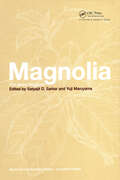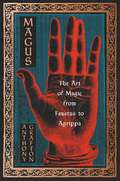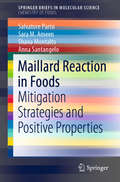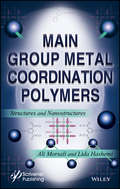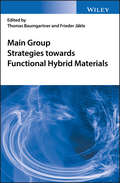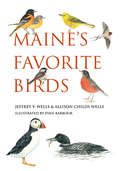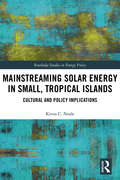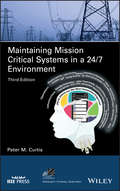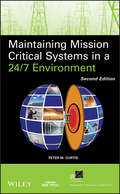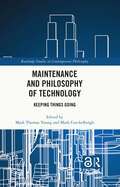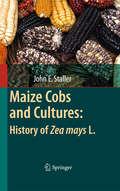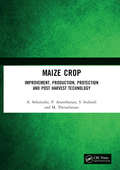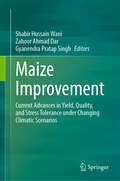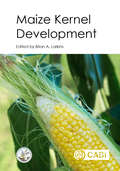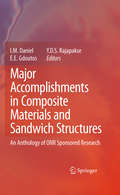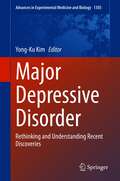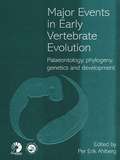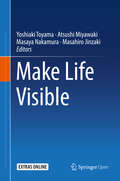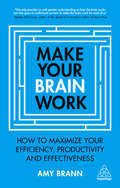- Table View
- List View
Magnolia: The Genus Magnolia
by Satyajit D. Sarker Yuji MaruyamaThe genus Magnolia consists of several medicinally important species most of which come from Far East Asia. Many species of this genus have traditionally been used in China and Japan to treat various illnesses from simple headaches to complicated cancer, and because of their versatility have more recently been incorporated into commercially success
Magus: The Art of Magic from Faustus to Agrippa
by Anthony GraftonA revelatory new account of the magus—the learned magician—and his place in the intellectual, social, and cultural world of Renaissance Europe.In literary legend, Faustus is the quintessential occult personality of early modern Europe. The historical Faustus, however, was something quite different: a magus—a learned magician fully embedded in the scholarly currents and public life of the Renaissance. And he was hardly the only one. Anthony Grafton argues that the magus in sixteenth-century Europe was a distinctive intellectual type, both different from and indebted to medieval counterparts as well as contemporaries like the engineer, the artist, the Christian humanist, and the religious reformer. Alongside these better-known figures, the magus had a transformative impact on his social world.Magus details the arts and experiences of learned magicians including Marsilio Ficino, Pico della Mirandola, Johannes Trithemius, and Heinrich Cornelius Agrippa. Grafton explores their methods, the knowledge they produced, the services they provided, and the overlapping political and social milieus to which they aspired—often, the circles of kings and princes. During the late fifteenth and early sixteenth centuries, these erudite men anchored debates about licit and illicit magic, the divine and the diabolical, and the nature of “good” and “bad” magicians. Over time, they turned magic into a complex art, which drew on contemporary engineering as well as classical astrology, probed the limits of what was acceptable in a changing society, and promised new ways to explore the self and exploit the cosmos.Resituating the magus in the social, cultural, and intellectual order of Renaissance Europe, Grafton sheds new light on both the recesses of the learned magician’s mind and the many worlds he inhabited.
Mahale Chimpanzees
by Nakamura, Michio and Hosaka, Kazuhiko and Itoh, Noriko and Zamma, Koichiro Michio Nakamura Kazuhiko Hosaka Noriko Itoh Koichiro ZammaLong-term ecological research studies are rare and invaluable resources, particularly when they are as thoroughly documented as the Mahale Mountain Chimpanzee Project in Tanzania. Directed by Toshisada Nishida from 1965 until 2011, the project continues to yield new and fascinating findings about our closest neighbour species. In a fitting tribute to Nishida's contribution to science, this book brings together fifty years of research into one encyclopaedic volume. Alongside previously unpublished data, the editors include new translations of Japanese writings throughout the book to bring previously inaccessible work to non-Japanese speakers. The history and ecology of the site, chimpanzee behaviour and biology, and ecological management are all addressed through firsthand accounts by Mahale researchers. The authors highlight long-term changes in behaviour, where possible, and draw comparisons with other chimpanzee sites across Africa to provide an integrative view of chimpanzee research today.
Mahanadi River: The Environmental Challenges and Way Forward
by Ajay Kumar Mishra Jay Prakash BhattThis book covers an overview of the Mahanadi River basin, spanning a total area of 141,581 square kilometers and extending across the states of Chhattisgarh (52.42%), Odisha (47.14%), Maharashtra (0.23%), Madhya Pradesh (0.11%), and Jharkhand (0.1%). It delves into the basin's hydro-development scenario, biodiversity, water quality, and sand mining, elucidating the pivotal role of the river in economic, social, and environmental viability of the eastern region of India. This volume emphasizes the environmental consequences stemming from unsustainable human activities such as river regulation, burgeoning settlements, sand mining, overfishing, and more. The Mahanadi River basin has been less explored for its biodiversity and environmental aspects compared to other prominent river basins like Ganga, Indus, Western Ghats, Godavari, and Krishna. This book seeks to fill this gap, offering new insights into the Mahanadi basin. The chapters address all dimensions of the environment, including social, ecological, engineering, and economic aspects, making it a multidisciplinary work. The book is tailored for audiences with backgrounds in social studies, engineering, biodiversity, and ecology.
Maillard Reaction in Foods: Mitigation Strategies and Positive Properties (SpringerBriefs in Molecular Science)
by Salvatore Parisi Sara M. Ameen Anna Santangelo Shana MontaltoThis book provides an overview of mitigation strategies and positive health effects of Maillard Reaction products in the contexts of food processing and storage. The effects of Maillard Reactions can vary considerably: while on the one hand certain sensorial alterations and influences on color, flavor and odor may be desirable, Maillard Reactions can also result in potentially harmful and toxic products (e.g. furfurals, furosines, or acrylamide). This book discusses possible mitigation strategies for the reduction of toxic reaction products, including the addition of enzymes or antioxidants, reducing sugars, and encapsulation approaches, as well as new processing strategies, such as high-pressure, radio-frequency, ultrahigh-temperature, or Ohmic heating methods. The book also illustrates that certain Maillard products can even produce positive health effects, e.g. antimicrobial or anticarcinogenic effects. The methods described here can serve as a blueprint for promoting the formation of beneficial compounds and reducing / avoiding toxic substances, offering essential strategies and methods.
Main Group Metal Coordination Polymers: Structures and Nanostructures
by Ali Morsali Lida HashemiCoordination polymer is a general term used to indicate an infinite array composed of metal ions which are bridged by certain ligands among them. This incorporates a wide range of architectures including simple one-dimensional chains with small ligands to large mesoporous frameworks. Generally, the formation process proceeds automatically and, therefore, is called a self-assembly process. In general, the type and topology of the product generated from the self-assembly of inorganic metal nodes and organic spacers depend on the functionality of the ligand and valences and the geometric needs of the metal ions used. In this book the authors explain main group metal coordination polymer in bulk and nano size with some of their application, synthesis method and etc, The properties of these efficient materials are described at length including magnetism (long-range ordering, spin crossover), porosity (gas storage, ion and guest exchange), non-linear optical activity, chiral networks, reactive networks, heterogeneous catalysis, luminescence, multifunctional materials and other properties.
Main Group Strategies for Functional Hybrid Materials
by Thomas Baumgartner Frieder JaekleShowcases the highly beneficial features arising from the presence of main group elements in organic materials, for the development of more sophisticated, yet simple advanced functional materials Functional organic materials are already a huge area of academic and industrial interest for a host of electronic applications such as Organic Light-Emitting Diodes (OLEDs), Organic Photovoltaics (OPVs), Organic Field-Effect Transistors (OFETs), and more recently Organic Batteries. They are also relevant to a plethora of functional sensory applications. This book provides an in-depth overview of the expanding field of functional hybrid materials, highlighting the incredibly positive aspects of main group centers and strategies that are furthering the creation of better functional materials. Main Group Strategies towards Functional Hybrid Materials features contributions from top specialists in the field, discussing the molecular, supramolecular and polymeric materials and applications of boron, silicon, phosphorus, sulfur, and their higher homologues. Hypervalent materials based on the heavier main group elements are also covered. The structure of the book allows the reader to compare differences and similarities between related strategies for several groups of elements, and to draw crosslinks between different sections. The incorporation of main group elements into functional organic materials has emerged as an efficient strategy for tuning materials properties for a wide range of practical applications Covers molecular, supramolecular and polymeric materials featuring boron, silicon, phosphorus, sulfur, and their higher homologues Edited by internationally leading researchers in the field, with contributions from top specialists Main Group Strategies towards Functional Hybrid Materials is an essential reference for organo-main group chemists pursuing new advanced functional materials, and for researchers and graduate students working in the fields of organic materials, hybrid materials, main group chemistry, and polymer chemistry.
Maine's Favorite Birds
by Jeffrey V. Wells Allison Childs Wells Evan BarbourFrom lush forests and rocky coastlines to lakes, mountains, and rolling fields, spectacular natural beauty and diverse habitats make Maine a wonderful place for seeing and hearing some of North America's most iconic birds. This fresh new book highlights the birds that are loved by Mainers and essential to why millions of tourists visit each year. Written by well-known birders and native Mainers, and based on their years of experience answering questions, leading bird walks, and teaching people about birds, Maine's Favorite Birds puts the focus on Maine's most-loved and best-known birds. This makes the book uniquely suited to bird enthusiasts who want to identify and learn more about the birds around them without the expense and confusion of more advanced field guides. Maine's Favorite Birds features each bird beautifully illustrated in large format, accompanied by clear and concise identification tips, habitat references, and easy-to-remember song descriptions. It also includes birding hot spots and ways birders can put their observations to use for science and conservation. Maine's Favorite Birds is perfect for everyone from kids to grandparents, parents to teachers, Mainers and tourists alike anyone who wants to know and better appreciate the birds they see in backyards, parks, wild areas, and nature preserves.
Mainstreaming Solar Energy in Small, Tropical Islands: Cultural and Policy Implications (Routledge Studies in Energy Policy)
by Kiron C. NealeThis book explores how cultural considerations can improve policymaking to achieve mainstream solar energy in small, tropical islands. Focusing on Trinidad, Barbados and Oʻahu, Kiron C. Neale looks at how culture can affect and be affected by the policies that support the household adoption of two key energy technologies: solar water heating and photovoltaics. Drawing on interviews with residents and energy officials, and an examination of the institutional, socio-economic and physical factors that affect energy systems such as governance structures and energy resource availability, the author explores themes including the impact of insularity on energy transitions and behavioural and cultural change. Overall, this book rebrands policies as instruments of cultural change and puts forward recommendations applicable to all small, tropical islands. Following the islands’ transition to renewable energy, this book will be of great interest to scholars of energy policy, energy transitions, climate change, cultural studies and small states development, as well as industry professionals working on energy policy implementation.
Maintaining Mission Critical Systems in a 24/7 Environment (IEEE Press Series on Power and Energy Systems #61)
by Peter M. CurtisThe new edition of the leading single-volume resource on designing, operating, and managing mission critical infrastructure Maintaining Mission Critical Systems in a 24/7 Environment provides in-depth coverage of operating, managing, and maintaining power quality and emergency power systems in mission critical facilities. This extensively revised third edition provides invaluable insight into the mission critical environment, helping professionals and students alike understand how to sustain continuous functionality, minimize the occurrence of costly unexpected downtime, and guard against power disturbances that can damage any organization's daily operations. Bridging engineering, operations, technology, and training, this comprehensive volume covers each component of specialized systems used in mission critical infrastructures worldwide. Throughout the text, readers are provided the up-to-date information necessary to design and analyze mission critical systems, reduce risk, comply with current policies and regulations, and maintain an appropriate level of reliability based on a facility's risk tolerance. Topics include safety, fire protection, energy security, and the myriad challenges and issues facing industry engineers today. Emphasizing business resiliency, data center efficiency, cyber security, and green power technology, this important volume: Features new and updated content throughout, including new chapters on energy security and on integrating cleaner and more efficient energy into mission critical applications Defines power quality terminology and explains the causes and effects of power disturbances Provides in-depth explanations of each component of mission critical systems, including standby generators, raised access floors, automatic transfer switches, uninterruptible power supplies, and data center cooling and fuel systems Contains in-depth discussion of the evolution and future of the mission critical facilities industry Includes PowerPoint presentations with voiceovers and a digital/video library of information relevant to the mission critical industry Maintaining Mission Critical Systems in a 24/7 Environment is a must-read reference and training guide for architects, property managers, building engineers, IT professionals, data center personnel, electrical & mechanical technicians, students, and others involved with all types of mission critical equipment.
Maintaining Mission Critical Systems in a 24/7 Environment, 2nd Edition
by Peter M. CurtisThis book is meant to offer Architects, Property Mangers, Facility Managers, Building Engineers, Information Technology Professionals, Data Center Personnel, Electrical & Mechanical Technicians and students in undergraduate, graduate, or continuing education programs relevant insight into the Mission Critical Environment with an emphasis on business resiliency, data center efficiency, and green power technology. Industry improvements, standards, and techniques have been incorporated into the text and address the latest issues prevalent in the Mission Critical Industry. An emphasis on green technologies and certifications is presented throughout the book. In addition, a description of the United States energy infrastructure's dependency on oil, in relation to energy security in the mission critical industry, is discussed. In conjunction with this, either a new chapter will be created on updated policies and regulations specifically related to the mission critical industry or updates to policies and regulations will be woven into most chapters. The topics addressed throughout this book include safety, fire protection, energy security and data center cooling, along with other common challenges and issues facing industry engineers today.
Maintenance and Philosophy of Technology: Keeping Things Going (Routledge Studies in Contemporary Philosophy)
by Mark Coeckelbergh Mark Thomas YoungWhat can we learn about the nature of technology by studying practices of maintenance and repair? This volume addresses this question by bringing together scholarship from philosophers of technology working at the forefront of this emerging and exciting topic.The chapters in this volume explore how attending to maintenance and repair can challenge and complement existing ways of thinking about technology focused on use and design and introduce new philosophical perspectives on the relationship between technology, time and human practice. They examine the significance of maintenance and repair practices at different scales in relation to a diverse range of philosophical traditions and a wide variety of technologies, from urban infrastructure such as bridges and buildings to data technologies such as servers and software systems. Together, the contributions highlight common themes in the philosophical study of maintenance, including the role of skill, the significance of social values and the potential of these practices to transform the technologies to which they are applied. By reflecting on the different ways in which we keep technologies going, from the devices we use in our homes to the large technical systems which surround us, this volume reveals the philosophical significance of practices of maintenance, not only as a source of new insights but also as a resource for enriching our understanding of a variety of existing topics in philosophy.Maintenance and Philosophy of Technology will appeal to scholars and advanced students working in philosophy of technology, philosophy of engineering and science & technology studies.Chapter 9 of this book is freely available as a downloadable Open Access PDF at www.taylorfrancis.com under a Creative Commons Attribution-Non Commercial-No Derivatives (CC-BY-NC-ND) 4.0 license.
Maize Cobs and Cultures: History of Zea mays L.
by John StallerOur perceptions and conceptions regarding the roles and importance of maize to ancient economies is largely a product of scientific research on the plant itself, developed for the most part out of botanical research, and its recent role as one of the most important economic staples in the world. Anthropological research in the early part of the last century based largely upon the historical particularistic approach of the Boasian tradition provided the first evidence that challenged the assumptions about the economic importance of maize to sociocultural developments for scholars of prehistory. Subsequent ethnobotanic and archaeological studies showed that the role of maize among Native American cultures was much more complex than just as a food staple. In Maize Cobs and Cultures, John Staller provides a survey of the ethnohistory and the scientific, botanical and biological research of maize, complemented by reviews on the ethnobotanic, interdisciplinary and multidisciplinary methodologies.
Maize Crop: Improvement, Production, Protection and Post Harvest Technology
by A. Solaimalai P. Anantharaju S. Irulandi M. TheradimaniMaize is one of the versatile emerging crops with wider adaptability under varied agro-climatic conditions. Globally, maize is known as queen of cereals because it has the highest genetic yield potential among the cereals. It is cultivated on nearly 150 m/ha in about 160 countries having wider diversity of soil, climate, biodiversity and management practices that contributes 36 % (782 m/t) inthe global grain production. The United States of America (USA) is the largest producer of maize contributes nearly 35 % of the total production in the world. It is the driver of the US economy. This book talks about the improvement, production, protection and post harvest technology of the maize crop. Note: T& F does not sell or distribute the Hardback in India, Pakistan, Nepal, Bhutan, Bangladesh and Sri Lanka.
Maize Improvement: Current Advances in Yield, Quality, and Stress Tolerance under Changing Climatic Scenarios
by Shabir Hussain Wani Zahoor Ahmad Dar Gyanendra Pratap SinghMaize is one of the most generally grown cereal crops at global level, followed by wheat and rice. Maize is the major crop in China both in terms of yield and acreage. In 2012, worldwide maize production was about 840 million tons. Maize has long been a staple food of most of the global population (particularly in South America and Africa) and a key nutrient resource for animal feed and for food industrial materials. Maize belts vary from the latitude 58° north to the latitude 40° south, and maize ripens every month of the year. Abiotic and biotic stresses are common in maize belts worldwide. Abiotic stresses (chiefly drought, salinity, and extreme temperatures), together with biotic stresses (primarily fungi, viruses, and pests), negatively affect maize growth, development, production and productivity. In the recent past, intense droughts, waterlogging, and extreme temperatures have relentlessly affected maize growth and yield. In China, 60% of the maize planting area is prone to drought, and the resultant yield loss is 20%–30% per year; in India, 25%–30% of the maize yield is lost as a result of waterlogging each year. The biotic stresses on maize are chiefly pathogens (fungal, bacterial, and viral), and the consequential syndromes, like ear/stalk rot, rough dwarf disease, and northern leaf blight, are widespread and result in grave damage. Roughly 10% of the global maize yield is lost each year as a result of biotic stresses. For example, the European corn borer [ECB, Ostrinianubilalis (Hübner)] causes yield losses of up to 2000 million dollars annually in the USA alone in the northern regions of China, the maize yield loss reaches 50% during years when maize badly affected by northern leaf blight. In addition, abiotic and biotic stresses time and again are present at the same time and rigorously influence maize production. To fulfill requirements of each maize-growing situation and to tackle the above mentions stresses in an effective way sensibly designed multidisciplinary strategy for developing suitable varieties for each of these stresses has been attempted during the last decade. Genomics is a field of supreme significance for elucidating the genetic architecture of complex quantitative traits and characterizing germplasm collections to achieve precise and specific manipulation of desirable alleles/genes. Advances in genotyping technologies and high throughput phenomics approaches have resulted in accelerated crop improvement like genomic selection, speed breeding, particularly in maize. Molecular breeding tools like collaborating all omics, has led to the development of maize genotypes having higher yields, improved quality and resilience to biotic and abiotic stresses. Through this book, we bring into one volume the various important aspects of maize improvement and the recent technological advances in development of maize genotypes with high yield, high quality and resilience to biotic and abiotic stresses
Maize In The Third World
by Christopher DowswellMaize is the world's most widely grown cereal and a dietary staple throughout the Third World, but its full potential has only begun to be tapped. This book thoroughly examines the biological and economic issues relevant to improving the productivity of maize in developing countries. The authors explore a wide range of practical problems, from maxi
Maize Kernel Development
by Brian A. LarkinsThis is an authoritative book that acts as a guide to understanding maize kernel development. Written by a team of experts, it covers topics spanning pre- and post-fertilization events, embryo and endosperm development, grain filling and maturation, and factors influencing crop yield. It explores the significance of maize and other cereal grains, existing hypotheses and research, and important gaps in our knowledge and how we might fill them. This is a valuable resource for researchers of maize and other cereals, and anyone working on basic or applied science in the fields of seed development, plant genetics, and crop physiology.
Major Accomplishments in Composite Materials and Sandwich Structures
by Yapa D.S. Rajapakse E. E. Gdoutos I. M. DanielThis book represents a collection of major research contributions over the last decade in the area of composite materials and sandwich structures supported by the U.S. Office of Naval Research. It contains over thirty chapters written by recognized experts in their fields and serves as a reference and guide for future research. Topics covered include: mechanical and failure characterization of composites under static and dynamic loading; failure modes and failure criteria; environmental effects; dynamic effects; post impact behavior; multiscale modeling; nanocomposites; characterization of core materials for sandwich structures under static and fatigue loading; mechanical behavior and failure of sandwich structures; fatigue behavior and durability of composite materials and sandwich structures; core joints in sandwich structures; characterization and failure of marine materials and structures under impulse loading; failure of interfaces under dynamic loading; delamination failure of composite materials and sandwich structures; response of composites and sandwich structures to blast loading and underwater explosions.
Major Depressive Disorder: Rethinking and Understanding Recent Discoveries (Advances in Experimental Medicine and Biology #1305)
by Yong-Ku KimThis book reviews all aspects of major depressive disorder (MDD), casting light on its neurobiological underpinnings and describing the most recent advances in management. The book is divided into four sections, the first of which discusses MDD from a network science perspective, highlighting the alterations in functional and structural connectivity and presenting insights achieved through resting state functional MRI and the development of neuroimaging-based biomarkers. The second section examines important diagnostic and neurobiological issues, while the third considers the currently available specific treatments for MDD, including biofeedback, neurofeedback, cognitive behavioral therapy, acceptance and commitment therapy, neuromodulation therapy, psychodynamic therapy, and complementary and alternative medicine. A concluding section is devoted to promising emerging treatments, from novel psychopharmacological therapies through to virtual reality treatment, immunotherapy, biomarker-guided tailored therapy, and more. Written by leading experts from across the world, the book will be an excellent source of information for both researchers and practitioners.
Major Events in Early Vertebrate Evolution
by Per Erik AhlbergA multi-author volume Major Events in Early Vertebrate Evolution examines the origin and early evolution of the backboned animals (vertebrates)-the group which comprises all fishes, amphibians, reptiles, birds and mammals, including ourselves. This volume draws together evidence from fossils, genes, and developmental biology (the study of how embry
Make It Glow: LED Projects for the Whole Family
by Emily Coker Kelli TownleyEveryone loves to play with light and this collection of kid-ready LED projects will have young Makers exploring electricity and electronics while opening up a world of endless fun! Makers, tinkerers, hobbyists, and parents will be drawn to the decorative and exciting possibilities of the projects in Make It Glow. Filled with full-color photographs and step-by-step instructions that anyone can follow, this beautiful book features 21 exciting projects that can be completed by even the youngest Maker. You'll start with ultra simple projects and then tackle increasingly complicated ones. Building upon lessons learned in earlier projects ensures that kids learn and succeed. Everyone will be thrilled by the fun, decorative designs that result as you develop new ways to unleash your creativity!With Make It Glow, you'll learn to make: Blue-light greeting cardsEyes in the dark FlickerbugsLight-up fairy wingsAn illuminated tote bagA bouquet of electric rosesand more!Featuring beautifully photographed inspirational projects for kids and adults, Make It Glow helps you learn the basics of electronics and soft circuits to create costumes, home decorations, clothing, jewelry, and more. What will you illuminate?
Make Life Visible
by Masaya Nakamura Yoshiaki Toyama Atsushi Miyawaki Masahiro JinzakiThis open access book describes marked advances in imaging technology that have enabled the visualization of phenomena in ways formerly believed to be completelyimpossible. These technologies have made major contributions to the elucidation of the pathology of diseases as well as to their diagnosis and therapy. The volume presents various studies from molecular imaging to clinical imaging. It also focuses on innovative, creative, advanced research that gives full play to imaging technology inthe broad sense, while exploring cross-disciplinary areas in which individual research fields interact and pursuing the development of new techniques where they fuse together. The book is separated into three parts, the first of which addresses the topic of visualizing and controlling molecules for life. Th e second part is devoted to imaging of disease mechanisms, while the final part comprises studies on the application of imaging technologies to diagnosis and therapy. Th e book contains the proceedings of the 12th Uehara International Symposium 2017, “Make Life Visible” sponsored by the Uehara Memorial Foundation and held from June 12 to 14, 2017. It is written by leading scientists in the field and is an open access publication under a CC BY 4.0 license.
Make Time for the Stars
by Antony CookeMany amateur astronomers are short of time. A full-time career usually takes up most waking hours, and often there simply isn't time for leisurely observing. Fortunately, modern technologies such as computer-controlled telescopes, GPS, north-seeking and level detection, have made telescope set-up much quicker. Today's imaging systems enable astronomers to take excellent astrophotographs without the hours-long exposures. Make Time for the Stars explains what to try on a tight schedule, and how to use today's equipment to get the most astronomy out of the least time. This book showcases a wide array of quickly performed astronomical projects, including various novel or new approaches to observing. There are also practical tips for maximizing time at the telescope, extracting optimal performance, quick and efficient set-up, and easily carried out optical maintenance. Significantly, the book features detailed information on alternative imaging techniques with simple and less time-consuming efforts.
Make Your Brain Work: How to Maximize Your Efficiency, Productivity and Effectiveness (Kogan Page Ser.)
by Amy BrannDo you know how your brain functions? Do you sometimes feel like you're fighting your own brain and habits in order to be productive at work? What if there was a way to work with your brain to become more efficient, effective and productive... and transform the way you operate? Make Your Brain Work is here to help. Author Amy Brann is fascinated by the application of brain science to business, and you don't have to be an expert to understand - she explains the principles and latest insights in practical and easy-to-understand language, enabling you to understand the way you work, and form the helpful habits that will revolutionize your output. With clear, in-context examples; hands-on tips; and focused case studies on how companies are doing things well and the pitfalls to avoid, this entertaining book will help you reduce the stress and overwhelm of poor time management, and help get you to that next professional level. Including brand-new content on developing resilience and creativity, and managing your work-life balance, now it's even easier to Make Your Brain Work!
